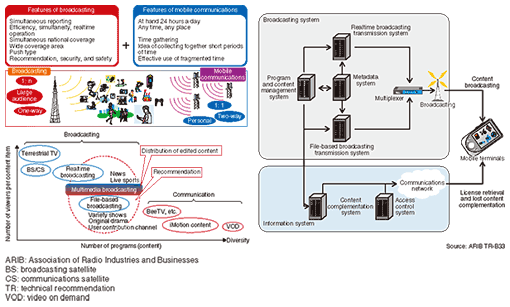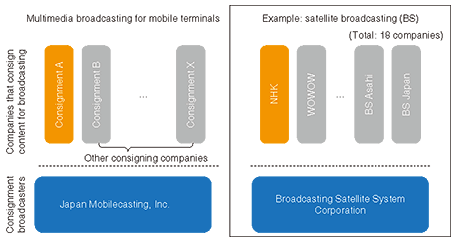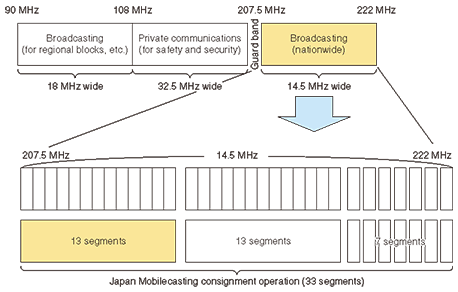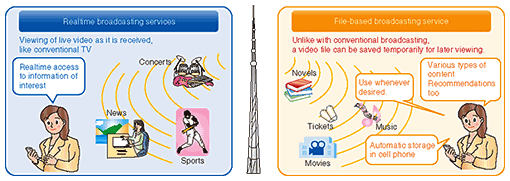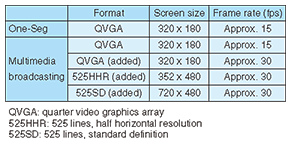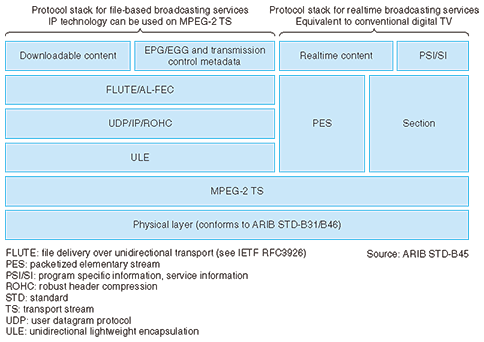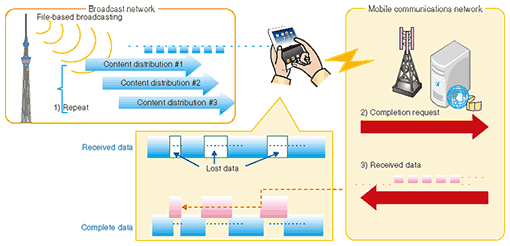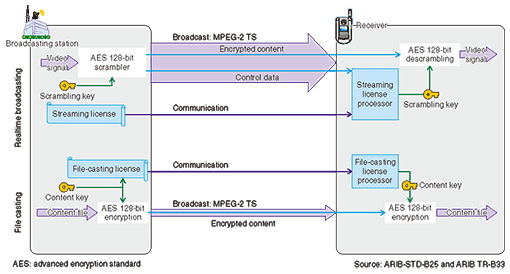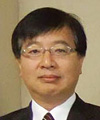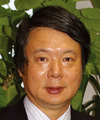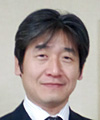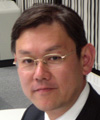 |
|||||||||||||||||||||||
|
|
|||||||||||||||||||||||
|
Feature Articles: Latest Trends of Multimedia Broadcasting Technologies for Mobile Terminals Vol. 9, No. 8, pp. 48–54, Aug. 2011. https://doi.org/10.53829/ntr201108fa7 Service and Technology Overview of Multimedia Broadcasting for Mobile TerminalsAbstractThis article briefly explains the multimedia broadcasting service for mobile terminals planned to start in Japan in spring 2012, after the frequency band currently used for terrestrial analog broadcasting became available in July 2011, and the technology that will support it. This service is based on the ISDB-Tmm (integrated services digital broadcasting, terrestrial mobile multimedia) system. Part of the system will use technology from NTT’s research and development.
1. IntroductionMultimedia broadcasting for mobile terminals is scheduled to begin in Japan in spring 2012 using the ISDB-Tmm (integrated services digital broadcasting, terrestrial mobile multimedia) system* in the frequency band from 207.5 MHz to 222 MHz that became available after terrestrial analog television (TV) broadcasting ended in July 2011 [1].
The ISDB-Tmm broadcasting system is an expansion of the ISDB-T (T: terrestrial) system [2], [3] being used for terrestrial digital TV broadcasting and provides a service that combines two media, communications and broadcasting, which have different characteristics. As major features, the system makes use of the excellent mobile reception of terrestrial digital TV and offers extended capabilities such as improved video quality, the transfer of various kinds of large files such as video and voice, and interworking with communication functions. The main divisions in the system configuration are the broadcasting system and the information system. This article describes the planned application of technology that arose from NTT’s research and development (Fig. 1).
In September 2010, the Ministry of Internal Affairs and Communications authorized Multimedia Broadcasting (mmbi) [4] as a consignment broadcaster (explained below) using a framework that separates hardware and software in the implementation of multimedia broadcasting in the form of consignment broadcasting and consigned content broadcasting [5]. mmbi then established Japan Mobilecasting, Inc. [6] in January 2011 and transferred the license to operate as a consignment broadcaster in February of that year (Fig. 2).
A broadcasting content consigner creates and organizes the programming, performs authentication, and handles charges and settlement as well as the broadcasting work for delivering the program; a consignment broadcaster broadcasts the data received from the consigner nationwide. Of the frequency band opened up by the ending of analog broadcasting (90–222 MHz), 33 segments for nationwide broadcasting (207.5–222 MHz) are planned for use by Japan Mobilecasting, and mmbi is planning to enter the consignment broadcasting business (Fig. 3).
2. Services provided by multimedia broadcastingsServices that are provided by multimedia broadcasting are broadly classified as those provided by realtime systems and those provided by stored content systems (Fig. 4).
2.1 Realtime broadcastingRealtime broadcasting services involve program viewing at the time of the broadcast. That is to say, realtime broadcasting can be regarded as corresponding to the one-segment broadcasting (One-Seg) offered for cell phones and mobile terminals, but multimedia broadcasting extends that service in the ways described below. (1) Improved quality The quality of video in multimedia broadcasting supplements the One-Seg specification with three additional schemes (Table 1). ISDB-TMM uses 13 segments in contrast with One-Seg. Thus, even video that contains fast motion can be viewed clearly, and viewing with sufficient image quality is possible on large-screen tablets and smart phones and even on larger external displays that have HDMI (high-definition multimedia interface) as well as on conventional cell phones. For good audio quality, HE-AAC (high-efficiency advanced audio coding) and HE-AACv2 are provided in addition to the MPEG-2 AAC used for One-Seg. In the future, MPEG Surround will also be available as soon as the environment for it is prepared.
(2) Improved interworking with other media One-Seg broadcasting also provided functions for interworking with various media, initiated by a TV program. Nevertheless, that system was focused on TV, and the interworking with other media was not necessarily active. In multimedia broadcasting, on the other hand, communication-derived content offered via a communication function is handled with relative freedom by the receiver. Multimedia broadcasting also inherently involves two different types of broadcasting system (realtime and stored). Because of those and other such factors, the system is being extended in the direction of improved interworking with One-Seg, multimedia broadcasting (both realtime and stored), and communication-derived content, etc., assuming that the receiving cell phones, which were originally planned to be the multimedia broadcasting receivers, will be equipped with those functions. In other words, the communication function can be considered to be a standard function of multimedia broadcasting receivers. To take fullest advantage of that feature, the system is being configured to deliver broadcast content and communication-derived content through seamless interworking. 2.2 File-based broadcastingService provision by file-based broadcasting differs from realtime broadcasting in that the time scheduling and duration of viewing or use of the content is not the same as the scheduling and duration of the broadcast. That is to say, as the term file-based indicates, the service assumes that the receivers receive and temporarily store the broadcast content before it is actually viewed or used. Thus, good content viewing or use can be expected even in locations that have poor reception of broadcast waves, such as underground areas or inside buildings. The content that is received and stored is in the form of ordinary files that are widely used by personal computers, so e-books, games, and various other types of content that cannot be handled by conventional broadcasting can be provided as well as video and audio. Because services can be premised on the receiver having a communication function, as mentioned above, services that are highly aware of interworking with the communication function are being planned. 2.2.1 Transmission technologyA major feature of file-based broadcasting is that any file can be delivered in a broadcast. To implement that feature, the protocol stack shown in Fig. 5 and IP (Internet protocol) transmission technology are used. This transmission system has an application-layer forward error correction (AL-FEC) function that provides powerful error correction that can handle data loss over an extended time period—something that is difficult for the FEC function of the radio physical layer.
2.2.2 Stored content complementation technologyAlthough multimedia broadcasting uses powerful error correction to overcome errors in the received data caused by deterioration of broadcast reception conditions, if the limits of that function are exceeded (e.g., the receiver remains outside the broadcasting area), then the error correction function cannot produce the correct content. Nevertheless, content reception can be completed even though the broadcast has ended because the missing content can be received via the receiver’s communication function (Fig. 6).
2.2.3 EPG/ECG metadata technologyFile-based broadcasting differs from the conventional TV broadcasting service in that there is no concept of channels or scheduled times. On the other hand, file-based broadcasting requires content status management, for example, prior to broadcasting, during storage, and of viewable (usable) content, which is not required by the previous form of TV broadcasting. Another requirement is a function for managing content with respect to the receiver’s storage capacity and allowing the user to easily understand the storage status. The solution is electronic program guide & electronic content guide (EPG/ECG) metadata. This includes various types of information about individual programs and other items of content in the XML (extensible markup language) format that can be used by the receiver to present the user with information about content in a way that is easy to understand. It also provides a basis for recommending new content according to the user’s prior content viewing (usage history). 2.2.4 Content protection and access control technologyMultimedia broadcasting differs from the One-Seg service in that it assumes a charged broadcasting model. In other words, it must be possible to permit content viewing (use) by users who pay a charge, but restrict viewing by users who do not pay the charge. Content protection and access control technology fulfills that requirement. The main feature of the content protection and access control technology for multimedia broadcasting, as shown in Fig. 7, is delivery of the content by broadcasting and delivery of the license for viewing (using) the content via the communication channel. Another feature is the use of a stronger encryption algorithm than is used for previous digital broadcasting.
3. ConclusionMultimedia broadcasting takes advantage of the many excellent features of the current terrestrial digital TV and further improves content quality, offers a file-based broadcasting service, and achieves content diversification through interworking with the communications function. An even greater variety of functional extensions is planned for the future. The other Feature Articles in this set introduce metadata technologies in multimedia broadcasting for mobile terminals [7], access control in multimedia broadcasting for mobile terminals [8], and storage-based broadcasting in multimedia broadcasting for mobile terminals [9]. References
|
|||||||||||||||||||||||








